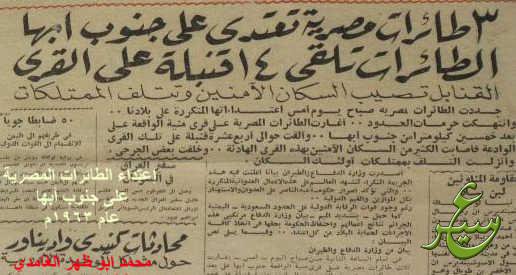فين كلمة الكيماوي في الخبر اللي في الجريدة ؟!
الكيماوي لا دخل له بالصوره الكيماوي استخدم باليمن وليس السعودية
هذه المعلومات عن الكيماوي
The first use of
gas took place on June 8, 1963 against Kawma, a village of about 100 inhabitants in northern Yemen, killing about seven people and damaging the eyes and lungs of twenty-five others.
[71] This incident is considered to have been experimental, and the bombs were described as "home-made, amateurish and relatively ineffective". The Egyptian authorities suggested that the reported incidents were probably caused by
napalm, not gas. The
Israeli Foreign Minister,
Golda Meir, suggested in an interview that Nasser would not hesitate to use gas against Israel as well.
[72] There were no reports of gas during 1964, and only a few were reported in 1965. The reports grew more frequent in late 1966. On December 11, 1966, fifteen gas bombs killed two people and injured thirty-five. On January 5, 1967, the biggest gas attack came against the village of Kitaf, causing 270 casualties, including 140 fatalities.
[73] The target may have been Prince Hassan bin Yahya, who had installed his headquarters nearby.
[74] The Egyptian government denied using poison gas, claiming that Britain and the US were using the reports as psychological warfare against Egypt. On February 12, 1967, it said it would welcome a UN investigation. On March 1,
U Thant said he was "powerless" to deal with the matter.
[75]
On May 10, the twin villages of Gahar and Gadafa in Wadi Hirran, where Prince Mohamed bin Mohsin was in command, were gas bombed, killing at least seventy-five.
[76] The
Red Cross was alerted and on June 2, it issued a statement in
Geneva expressing concern.
[77] The Institute of Forensic Medicine at the
University of Berne made a statement, based on a Red Cross report, that the gas was likely to have been halogenous derivatives –
phosgene,
mustard gas,
lewisite,
chlorine or
cyanogen bromide.
[78] The gas attacks stopped for three weeks after the
Six-Day War of June, but resumed on July, against all parts of royalist Yemen.
[79] Casualty estimates vary, and an assumption, considered conservative, is that the mustard and phosgene-filled aerial bombs caused approximately 1,500 fatalities and 1,500 injuries.
[73]


